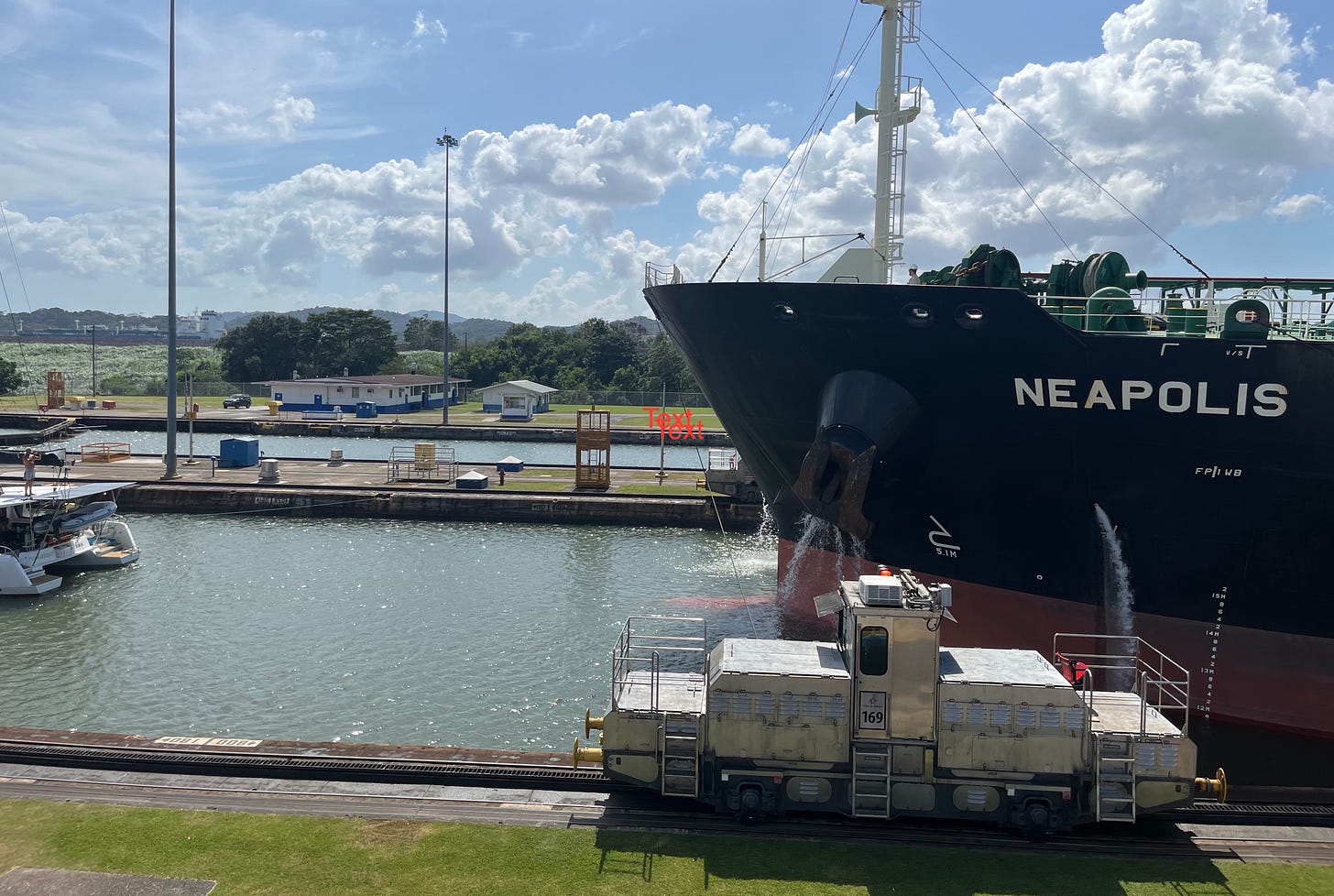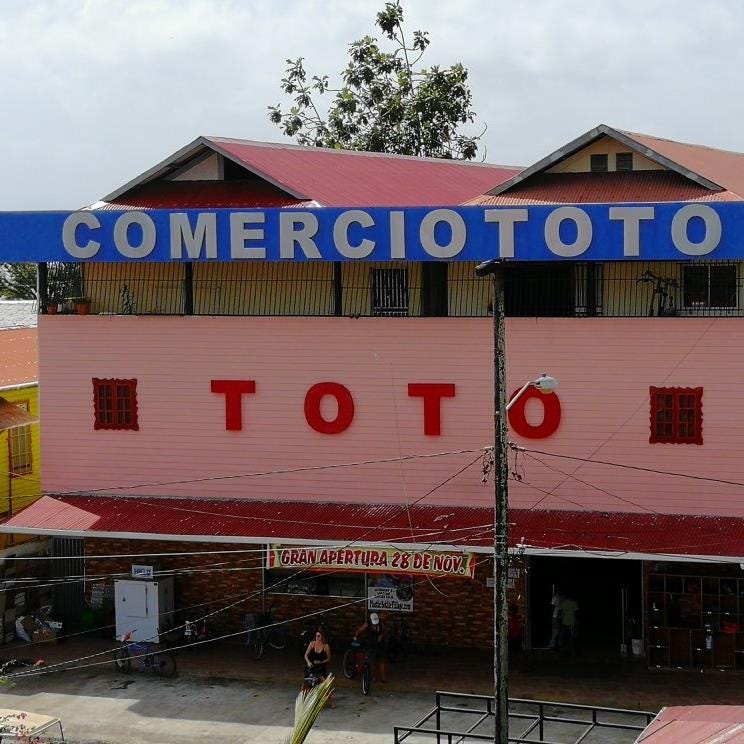Something happened on the way to the Panama Canal
A fiction writer meets current events head on

We had a topic all picked out.
Sometimes we plan out the topics for this weekly column very carefully. Other times the subject just walks up and punches us in the face.
Take this week for example. David has been in Panama for the last three weeks on a Spanish immersion trip. He frequently schedules a long trip to start immediately after the due date of a manuscript. It serves the dual purpose of motivation to get the manuscript done and allows a few weeks of brain-off time so he can return to the editing process with fresh eyes.
These longer trips are also research. The places he visits often end up as settings in a future book. In Threat Axis, Major Gao of the People’s Liberation Army tracks rogue operative Ian Thomas to El Chalten, a tiny hiking town in Patagonia. Chaos ensues. The store where the shoot-out happened was based on a real business in the town. David visited El Chalten in 2018.
That’s what this column was supposed to be about this week: how we research settings and use them in our writing.
Then this happened…
We were two-plus weeks into our viaje de español inmersión and set to visit the Miraflores Locks in the Panama Canal. For David, this was the highlight of the trip. In Command and Control, we used the Canal as a setting for one of Ian Thomas’s dirty tricks, and David was anxious to see the Real Deal.
As he was entering the building a guy approached holding a microphone, followed by a second guy with a camera. The microphone was a small lapel mic covered with a furry windscreen that made it look he was holding out a dead mouse.
“What do you think of America trying to take back the Panama Canal?” Microphone Guy demanded.
David stared at the furry thing in his hand, thinking, “Why is this guy holding a dead mouse?”
[I should mention at this point that these long trips involve a news fast. No American TV, no newspapers, no doom scrolling. In other words, I was caught flat-footed.]
In the blinding clarity of hindsight, I had three possible options:
Door #1 - Give the ridiculous question the answer it deserved.
Door #2 - Cock my head and say “No hablo inglés.”
Door #3 - My wife drags me into the building before I can put my foot in my mouth.
In his mind, David offered an erudite response in a calm and professional manner…but remember, he writes fiction for a living.
We went with Door #3.
A brief aside about the Panama Canal
If you ever have a chance to visit the Panama Canal, run—do not walk—toward that opportunity. It is cool beyond words and deserves recognition as the Eighth Wonder of the World.
It’s more than just an immense feat of engineering. Spend a few days in Panama melting in the heat. Take a short walk into the jungle and meet the local insect population. Walk along the 7-kilometer Amador Causeway that was built using rock excavated from the Canal.
Now imagine you’re living a hundred years ago. No air-conditioning, no bug spray, no modern excavating machinery, no ice for your gin-tonic.
And yet, despite the unbelievable odds, the Panama Canal was built. It’s a stark reminder of the great infrastructure projects that the United States used to tackle out in the world.
Current events with some local context
Apparently, whilst I was happily hablando-ing with mis compañeros de enspañol, the new Administration was making statements about “taking back” the Canal and ending Chinese involvement in the country.
I left Panama yesterday, a day before Secretary of State Rubio was set to arrive. I have no special insight into what Mr. Rubio plans to say or do, but since I spent the prior three weeks traveling around the country, visiting the Canal, and talking to actual Panamanian people, I can offer some context.
Panama values its sovereignty
Panamanians love Americans. Everywhere we went, we were met with smiles and friendly conversation. When Mr. Rubio’s visit was announced, the mood changed in Panama City. Overnight, the city was decked out in Panamanian flags. They were everywhere. Every lamppost, every flagpole, the sides of buildings. If there was a vertical pole, a flag was hanging on it.
A rumor circulated that the flags were hanging at half-mast in a show of disappointment in the current state of affairs between the US and Panama. It’s tough to say whether the flags were half-mast or not, but the chatter about taking back sovereign territory was not welcomed by anyone.
China is everywhere
There’s a lot of press coverage about how a Chinese company runs two major ports at either end of the Panama Canal. While true, this is hardly new information or even exceptional. As The Hill reported about the hastily scheduled Senate hearings on the Panama Canal:
…Chinese companies operate ports globally, suggesting that if China’s presence in Panama constitutes control, then similar arguments could be made about the Suez Canal, the Singapore Strait, the Mediterranean Sea and the English Channel. This global context raised questions about whether the hearing’s focus on Panama reflected genuine strategic concerns or simply broader anxieties about declining U.S. influence.
But the ranting Senators are not wrong. There is a very heavy Chinese (civilian) presence all over Panama. But not in the way you might expect. They are integrated into the society.
We spent over a week in Bocas del Toro, a tiny diving town on the Isla Colon on the Caribbean side of the country. The stores in this community are almost 100% Chinese owned and operated. If you’re buying any sort of everyday item or building supply, you will visit one of the enormous, cookie-cutter general stores.
They are ugly, they are pervasive, and they are not going anywhere.
Let’s add some historical context
We spent several afternoons with a sixty-ish Panamanian man who gave history lessons about his country--en español, por supuesto. We covered the sweep of history from the Spanish invasion through the building of the Canal and into present day. We also spent some time on the topic of the US and Chinese involvement in the country and how those relationships have changed over his lifetime.
Panama has a long relationship with the United States—and a good one, too. American companies built the Canal and much of the original infrastructure in Panama. The Canal was transitioned to Panamanian control in 1979 under the condition that the country remain under democratic control.
Our guide talked about the 1989 US invasion of Panama after dictator Manuel Noriega, a wanted drug kingpin, annulled the results of the general elections. The country was returned to the democratically elected Panamanian President in short order, although counter-drug ops continued for some time. JR spent two months in the country in 1993 as part of that effort.
Our guide described how when he was growing up, the Peace Corps was a visible presence in the region. Americans built schools, hospitals, and roads all over the country.
But that US presence changed dramatically after 9-11. The US attention shifted away from South and Central America to Afghanistan, Iraq, and the Global War on Terror. When the US stopped showing up, China stepped in.
It didn’t happen overnight. China wasn’t waiting in the wings to swoop in. It took years for this to happen. My Spanish teacher in Bocas grew up on the island. I asked him when the Chinese cookie-cutter general stores came in. They started arriving after 2010, nearly a decade after 9-11. By 2015, they were firmly entrenched in the local economy.
But here’s the thing: the locals are not happy about the way the Chinese have taken over business on the island. They would love to have America back in the game.
Mr. Rubio showing up in Panama is a good thing.
If you are able to look past the threats and the bravado, having the US Secretary of State show up in Panama a few days after the start of a new administration is a good thing. I mean, at least we’re showing up.
If my time in Panama has given me any insight at all, it’s that when we stop showing up in the world, China will emerge to fill the void. China didn’t “take over” the Panama Canal, we stopped engaging with an ally.
I’m not talking about the military, either. Our latest book, Proxy War, is all about China using economic power to take control of a region. It’s set in Central Asia, but it might as well be in Panama. It’s the same playbook.
Review of the Week
As we write this, Proxy War has been out for just shy of two weeks and the audiobook has (finally) been released. All the way from South Dakota, longtime reader Mike Beason weighs in with a 5-star verdict:
Imagine a time when an AI computer collects input, makes decisions, and executes strategy in a war. In Proxy War, that time is now.
We might have to steal that as a tagline, Mike.
From all the way over in the UK, longtime reader Ron Robson dropped a very generous review:
What an exciting read. Well researched and, as we can see with North Korean troops serving in Ukraine, highly plausible. This in a great read, plenty of exciting action and lots of intrigue plus the odd wild card as Don Riley juggles the balls he has been given to find a favourable outcome. This book was like vintage Clancy, plenty of pages, plenty of research and an excitingly plausible storyline. Well done. I have pre ordered the next one.
Thank you, Ron for all your support over the years.
Do you want to be part of the Review of the Week Club? Don’t be shy.
Be happy. Stay healthy. Read (or listen to) a book.
As always, thanks for being a supporter –
David & JR, AKA the Two Navy Guys
PS – Are you looking for the FREE download of Death of a Pawn?
PPS - This email is free, but it's not cheap. If you'd like to show your support, here's where you can find all the Two Navy Guys' books.
PPPS - If you enjoyed this post, you can get it delivered to your inbox every week for free.








Loved reading this. Panama was on our spring break list, but I see it's back in the news today.